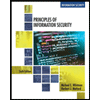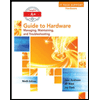What is the difference between packet fragmentation (i.e., at network layer) and frame frag- mentation (i.e., at link layer) in terms of purpose? Suppose that host A is connected to a router R1, R1 is connected to another router, R2, and R2 is connected to host B. Suppose that a TCP message that contains 800 bytes of data and 20 bytes of TCP header is passed to the IP function at host A for delivery to B. Show the Total length, DF, MF, and Fragment offset fields of the IP header in each packet transmitted over the three links. (Assume that link A-R1 can support a maximum frame size of 1024 bytes including a 14-byte frame header, link R1-R2 can support a maximum frame size of 512 bytes, including an 8-byte frame header, and link R2-B can support a maximum frame size of 432 bytes including a 12-byte frame header.) (*hint: the Fragment offset field is denominated by 8-bytes, not bytes)
What is the difference between packet fragmentation (i.e., at network layer) and frame frag- mentation (i.e., at link layer) in terms of purpose? Suppose that host A is connected to a router R1, R1 is connected to another router, R2, and R2 is connected to host B. Suppose that a TCP message that contains 800 bytes of data and 20 bytes of TCP header is passed to the IP function at host A for delivery to B. Show the Total length, DF, MF, and Fragment offset fields of the IP header in each packet transmitted over the three links. (Assume that link A-R1 can support a maximum frame size of 1024 bytes including a 14-byte frame header, link R1-R2 can support a maximum frame size of 512 bytes, including an 8-byte frame header, and link R2-B can support a maximum frame size of 432 bytes including a 12-byte frame header.) (*hint: the Fragment offset field is denominated by 8-bytes, not bytes)
A+ Guide To It Technical Support
10th Edition
ISBN:9780357108291
Author:ANDREWS, Jean.
Publisher:ANDREWS, Jean.
Chapter8: Network Infrastructure And Troubleshooting
Section: Chapter Questions
Problem 8TC
Related questions
Question

Transcribed Image Text:1. What is the difference between packet fragmentation (i.e., at network layer) and frame frag-
mentation (i.e., at link layer) in terms of purpose?
2. Suppose that host A is connected to a router R1, R1 is connected to another router, R2, and
R2 is connected to host B. Suppose that a TCP message that contains 800 bytes of data and
20 bytes of TCP header is passed to the IP function at host A for delivery to B. Show the
Total length, DF, MF, and Fragment offset fields of the IP header in each packet transmitted
over the three links. (Assume that link A-R1 can support a maximum frame size of 1024
bytes including a 14-byte frame header, link R1-R2 can support a maximum frame size of 512
bytes, including an 8-byte frame header, and link R2-B can support a maximum frame size
of 432 bytes including a 12-byte frame header.)
(*hint: the Fragment offset field is denominated by 8-bytes, not bytes)
3. What is the purpose of the path MTU discovery process (see textbook Figure 5-42) and why
does it need to set the DF bit in the IP headers?
Expert Solution
This question has been solved!
Explore an expertly crafted, step-by-step solution for a thorough understanding of key concepts.
Step by step
Solved in 3 steps

Knowledge Booster
Learn more about
Need a deep-dive on the concept behind this application? Look no further. Learn more about this topic, computer-science and related others by exploring similar questions and additional content below.Recommended textbooks for you

A+ Guide To It Technical Support
Computer Science
ISBN:
9780357108291
Author:
ANDREWS, Jean.
Publisher:
Cengage,

Principles of Information Security (MindTap Cours…
Computer Science
ISBN:
9781337102063
Author:
Michael E. Whitman, Herbert J. Mattord
Publisher:
Cengage Learning

Systems Architecture
Computer Science
ISBN:
9781305080195
Author:
Stephen D. Burd
Publisher:
Cengage Learning

A+ Guide To It Technical Support
Computer Science
ISBN:
9780357108291
Author:
ANDREWS, Jean.
Publisher:
Cengage,

Principles of Information Security (MindTap Cours…
Computer Science
ISBN:
9781337102063
Author:
Michael E. Whitman, Herbert J. Mattord
Publisher:
Cengage Learning

Systems Architecture
Computer Science
ISBN:
9781305080195
Author:
Stephen D. Burd
Publisher:
Cengage Learning

A+ Guide to Hardware (Standalone Book) (MindTap C…
Computer Science
ISBN:
9781305266452
Author:
Jean Andrews
Publisher:
Cengage Learning